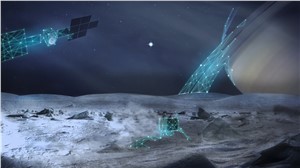
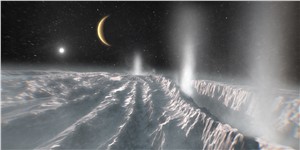
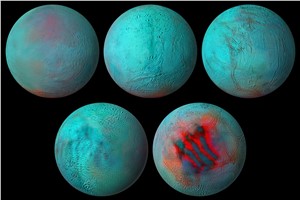
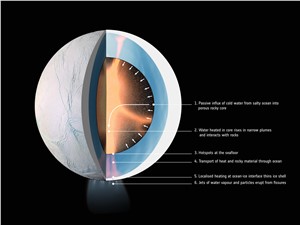
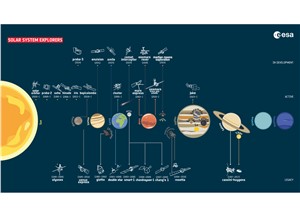
A fresh, icy crust hides a deep, enigmatic ocean. Plumes of water burst through cracks in the ice, shooting into space. An intrepid lander collects samples and analyses them for hints of life.
ESA has started to turn this scene into a reality, devising a mission to investigate an ocean world around either Jupiter or Saturn. But which moon should we choose? What should the mission do exactly? A team of expert scientists has delivered their findings.

A Global and Regional Analysis: Focus on Platform, Battery Type, Power, and Country Level Analysis
Download free sample pagesThe mission would follow Juice, LISA and NewAthena as the first ‘large-class’ mission of Voyage 2050, ESA’s long-term plan for space science activities. Its overarching theme – ‘moons of the giant Solar System planets’ – was chosen back in 2021. To translate this theme into more concrete mission concepts, ESA selected a committee of top planetary scientists to pool their knowledge and expertise.
Their task? To analyse the scientific merits of visiting various moons of Jupiter or Saturn, and help ESA map roads towards innovative technical solutions that would make such a mission possible.
Scientific priorities were set out as part of the Voyage 2050 recommendations: the mission should focus on the habitability of an ocean world by investigating the links between its interior and its surroundings, as well as searching for signs of past or present life, and seeking to identify life-enabling chemistry at the surface.
“The mission concepts that we have recommended would provide tremendous scientific return, driving forward our knowledge, and would be fundamental for the successful detection of biosignatures on icy moons,” says Dr Zita Martins, astrobiologist at Instituto Superior Técnico, who chaired the team of planetary scientists.
“I am very happy to have been part of this process, seeing first-hand the early steps that will potentially lead to the investigation of the moons of the giant planets by ESA. The search for habitable conditions and for signatures of life in the Solar System is challenging from a science and technology point of view, but very exciting!”
Ambitious but achievable. Always.
Of course, big dreams must always be kept within the bounds of what is technically feasible and financially affordable. As Dr Martin’s team focused on the science, teams of engineers within ESA’s Concurrent Design Facility (CDF) analysed what kind of mission would be realistic considering the technologies we expect to be developed within the next two decades.
“We commissioned three CDF studies focused on the most promising moons: Jupiter’s Europa and Saturn’s Enceladus and Titan,” elaborates Dr Frederic Safa, head of ESA’s Future Missions Department. “The team of scientists worked closely with the CDF engineers on the objectives of each study. The outcomes helped pin down what can be done with the resources that we will have in the 2040s.”
The results are in…
Aiming for transformational science, considering the characteristics of each moon and future planned missions to Jupiter and Saturn’s ocean worlds, the scientists identified Saturn’s moon Enceladus as the most compelling target, followed by Saturn’s moon Titan and then Jupiter’s moon Europa.
No space agency has ever landed on little Enceladus. And yet it has enormous potential for new science, particularly in the realm of habitability. It is generally accepted that there are three conditions for a ‘habitable environment’ to potentially support life as we know it: the presence of liquid water, a source of energy, and a specific set of chemical elements.
Enceladus checks all three boxes. The plumes that spew through its icy crust are rich in organic compounds, some of which are key for life. The ocean also seems to hold a powerful source of chemical energy that could fuel living organisms.
The impact of such a mission could be enormous It would offer Europe – once more – a unique front seat in Solar System science. “An investigation into signs of past or present life around Saturn has never been achieved before. It would guarantee ESA leadership in planetary science for decades to come,” says ESA Director of Science, Prof. Carole Mundell.
Standing on the shoulders of giants
Building upon ESA’s Jupiter Icy Moons Explorer (Juice) and the NASA/ESA/ASI Cassini-Huygens mission to visit Saturn and land on Titan, this new mission would carry next-generation instrumentation capable of revealing unimaginable secrets of an ocean world such as Enceladus. ESA could launch such a mission in the early 2040s with Ariane 6, arriving at its destination around a decade later. In the style of Juice and Cassini-Huygens, the mission – if targeted towards Enceladus or Titan – could perform a fantastic tour in the Saturn system, encompassing flybys of other puzzling moons, before a grand-finale close-up investigation of the chosen target.
To significantly advance European ambitions in planetary science, the team judged that the new mission must collect a sample of the ocean world, either using a lander or by flying close to the surface to sweep up material ejected by plumes. A mission to Enceladus would touch down at the moon’s thinly crusted south pole to collect ejected ocean material, whereas a mission to Titan should focus on lake sediments. In either case, an onboard laboratory equipped with miniaturised and highly sensitive instruments would unravel the biochemical secrets of the collected material.
Like Juice and Cassini-Huygens, our mission to the ‘moons of the giant Solar System planets’ will engage Europe’s foremost engineering and industrial capabilities to cope with enormous challenges, including limited solar energy, wildly varying temperatures and communication over huge distances. ESA is already overcoming similar challenges with Juice.
The new mission will boost European competences in many scientific and technological fields, including in-orbit assembly, operating in extreme environments, landing technologies, and novel scientific instrumentation. All these revolutionary technologies will have a wide range of applications, well beyond ESA’s space science programme.
Space science at ESA
ESA has launched about one large-class mission per decade, with current and previous examples being Juice, Rosetta, XMM-Newton and Herschel. Each has been an enormously challenging endeavour, requiring the deployment of completely new technologies and engaging the efforts of thousands of leading scientists and engineers. A robust and stable space science programme ensures European excellence in science and technology; the significant societal impact generates the multi-disciplinary growth that ESA is called to provide to its Member States.
This new large-class mission to the ‘moons of the giant planets’ is the first in a series of three envisaged for ESA’s Voyage 2050 programme, to be complemented by a selection of medium- and fast-class missions. Together, these will provide diversity and agility over the next two decades, satisfying the ambition of European scientific communities. “In carefully planning Voyage 2050, we are ensuring that ESA’s space science programme secures a world-class, forward-looking set of missions for future generations,” concludes Prof. Mundell.